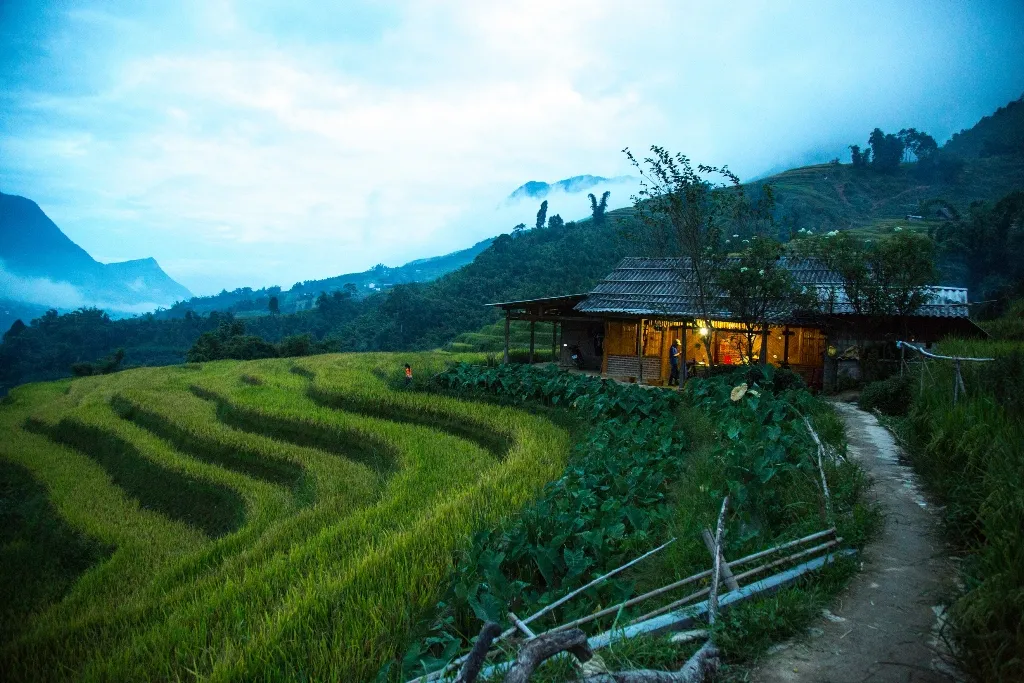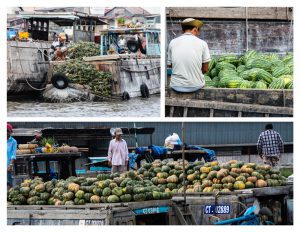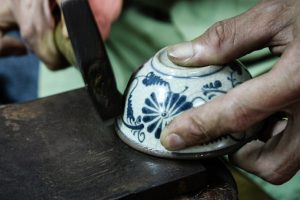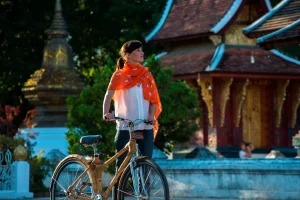Sapa is all about trekking and exploring the surrounding rice terraces and stunning landscapes. After a few nights at the gorgeous mountain lodge-style Victoria Sapa Resort & Spa, we sign up for a trek down to the Victoria Homestay in the lovely Muong Hoa Valley.

The experience promised a stay with an authentic H’mong family but with Victoria touches. Would it be a true local experience, we wondered? How would we be able to communicate with the family? What would a day in the valley be like? We were excited to have all our questions answered!
There were three options to get to the homestay: 1) A 2-hour walk along paved roads from the Ta Van Village, just a short drive away from Victoria Sapa Resort & Spa; 2) having a car drive us to the bottom of the hill and walk up the last 300m or so up to the homestay or 3) walk along uneven dirt paths from Ta Van to the homestay.
Feeling adventurous, we went with Option 3 and had a wonderful walk past small villages and along terraced rice fields in the incredibly scenic Muong Hoa Valley. More on that in another post! Suffice it to say that we arrived at the homestay having had a vigorous workout and tons of beautiful photos.
From the moment we turned the corner in the village of Lao Chai, navigating past lazy buffaloes and excited ducks, and saw the homestay, we breathed a sigh of relief. Yes, it was very authentic, a living, working home of a H’mong family set on their own land on which they plant rice for their family’s use.
It wasn’t at all like some of the other “homestays” we passed along the way with attached cafe, convenience store and laundry facilities… This was truly someone’s home which they were going to open up to us.

As we got closer, it felt like coming home when we saw the Victoria Homestay sign.

Waiting to greet us with one of the warmest smiles we’ve ever seen in all our travels was Moo, the wife and mother.

She told us that her name was actually pronounced “Maw” and that she was a 27-year-old mother of three.
Moo’s English is excellent, the product of years being a guide and souvenir seller to the many tourists that visit the town of Sapa. We sat down to a hot tea while Moo went about preparing a traditional herbal footbath for us, using medicinal leaves, branches and bark collected from the surrounding mountains.
Soaking our weary feet in the soothing bath which originated from the Red Dao ethnic minority, the steam rising from the wooden tub on a cold day, was absolutely perfect after a long trek. Looking out over the glorious valley floor was just a plus!

After our blissful footbath, we were ready to explore the surrounding area. The climate only allows for one rice harvest a year. During that time, the whole family works together to prepare the land and bring in the harvest.
At other times, the H’mong men are off tending to their animals or taking on extra work in town. The women are left in the villages to look after children. They also have time to make their own clothes, including batik and embroidery.

Moo showed us the hemp cloth she had just dyed in preparation for a new set of clothes.

Part of our trek included a batik class at the nearby home of a batik master. Read about it here, but suffice to say it was amazing to see the work and skill that goes into a piece of batik and being able to create our own designs was awesome.

After wandering around the village, we headed back to Moo’s in the late afternoon. Over a cup of tea, we learned a little about her and her lovely family. Moo’s husband plants cardamom in a forest about 20km away and her three adorable children go to a nearby school. They turn up just as Moo begins to prepare dinner.

While Moo speaks English, her children mainly speak H’mong and some Vietnamese. Even though they attend school in Vietnamese, they revert back to H’mong at home. We communicate through gestures, smiles and a phone.
We discover that the kids like math and we spend time working out math problems using the phone’s calculator. The littlest girl, Zoe, moves to turn on the TV with the volume waaaaay down low, casting us a sheepish smile. We signal to her that it’s okay to turn it up a bit and we laugh and dance over an old Kylie Minogue hit turned into a H’mong karaoke song.

We then wander over to the kitchen, an unfinished earthen-walled room where Moo is putting dinner together over an open fire.

Because of the heavy fog that sets into the valley every day, H’mong homes are typically closed, with few, if any windows. Otherwise, their clothes and blankets would mildew with the persistent moisture in the air.
It’s amazing what Moo is able to put together in such rustic conditions but we’re soon sitting down to a lovingly prepared feast, eaten family-style. There are fragrant potatoes in garlic, boiled black chicken (that had earlier been running around the house!), spring rolls and sauteed pork and green peppers. How she managed to serve it all hot at the same time is nothing short of a miracle.

We ask about the H’mong people and Moo and her husband are happy to answer. We hear about their simple yet fulfilling lives, far away from the bustling cities of Vietnam, a life that is very modest materially but rich in interactions – with lots of time spent with family, neighbors and friends.
It’s soon time for bed, and we head up the stairs to where we’ll be sleeping. There are mosquito nets for summer, but since we’re traveling in the Sapa winter, there’s no need for them tonight. We do make use of the space heater, though, and settle in to bed, the soft Victoria-standard linens a welcome touch of luxury. We set our alarm to wake up to see the sun rise over the valley and call it a night, tired but happy.

In the morning, we rub the sleep from our eyes, grab our cameras and head outside. The scenery that greets us is truly breathtaking.

In the morning light, we walk around and admire the gorgeous views from Moo’s home in every direction, surrounded by terraced rice fields.

Moo is up making breakfast, the kids are still asleep and we take the time to freshen up. The bathroom facilities are clean but rustic, a separate toilet and shower with hot water in a small building at the rear of the home. This experience reminds us a little of camping, but much more comfortable!

Again, we spot the Victoria amenities in the little places. Not enough to change the homestay feel, but just enough to make a difference.

Moo gives us a choice for breakfast: Vietnamese beef noodle soup (pho) or croissants and jams, provided by Victoria.

From the table, we spot village children making their way to school and think that their commute must be one of the most scenic anywhere in the world.

Pretty soon, the kids wake up, have breakfast and get ready for school. We can’t resist taking more photos of these happy, affectionate children we don’t even share a common language with.

But that’s been the whole purpose of this homestay – connecting with the real people of Sapa, living a day in their shoes, and experiencing quite a different yet beautiful world.











